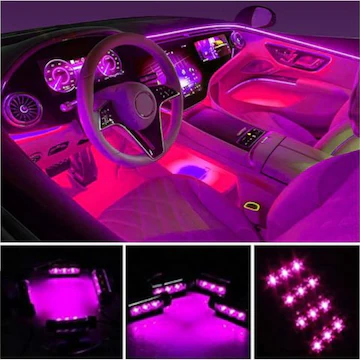
Automotive LED lighting has revolutionized the way vehicle owners approach visibility, aesthetics, and safety. From enhanced road illumination to stylish upgrades, LED lights have become a staple in modern automotive design. This guide will explore the benefits of automotive LED lighting, factors to consider when choosing products, and practical tips for installation. Additionally, it will highlight the importance of selecting reliable automotive LED lighting manufacturers for high-quality performance.
Understanding Automotive LED Lighting
LED, or Light Emitting Diode, technology offers several advantages over traditional halogen or incandescent bulbs. Unlike conventional lighting, LEDs produce brighter and more focused light while consuming less power. This makes them ideal for various automotive applications, including headlights, taillights, fog lights, interior lighting, and accent lighting.
The key feature of automotive LED lighting is its efficiency. LEDs convert most of the energy they consume into light rather than heat, unlike halogen bulbs that waste energy as heat. This not only reduces the vehicle’s energy consumption but also prolongs the life of the lighting system. High-quality LED lights can last tens of thousands of hours, significantly reducing the need for frequent replacements.
Benefits of Automotive LED Lighting
- Enhanced Visibility and Safety
One of the most significant advantages of LED lighting in vehicles is improved visibility. LED headlights produce a brighter, whiter light that closely resembles daylight, allowing drivers to see farther and clearer at night or in adverse weather conditions. This enhanced illumination reduces reaction time and improves overall road safety. - Energy Efficiency
LEDs require much less power than traditional halogen bulbs, which helps reduce the strain on the vehicle’s electrical system. This efficiency can contribute to lower fuel consumption in vehicles, especially in electric and hybrid models, where power management is crucial. - Longevity and Durability
Automotive LED lighting is highly durable, with a lifespan far exceeding that of conventional bulbs. LEDs are resistant to shock, vibrations, and extreme temperatures, making them perfect for vehicles that endure harsh conditions. This durability translates into long-term savings, as replacement and maintenance costs are significantly lower. - Design Flexibility
LEDs are compact and versatile, allowing for innovative design options. Vehicle manufacturers and aftermarket automotive LED lighting manufacturers can create custom shapes, strips, and patterns that enhance the aesthetics of both the interior and exterior of a vehicle. From sleek daytime running lights to dynamic turn signals, LEDs offer endless possibilities for creative expression. - Instant Illumination
LEDs turn on instantly, unlike traditional bulbs that may take a moment to reach full brightness. This feature is especially beneficial for brake lights and turn signals, where immediate illumination can prevent accidents and improve communication with other drivers.
Choosing the Right Automotive LED Lighting
Selecting the best LED lights involves careful consideration of several factors. First, identify the purpose of the lighting—headlights, interior illumination, or accent lighting. Each application may require different specifications for brightness, color temperature, and beam pattern.
Next, consider the quality and reputation of automotive LED lighting manufacturers. High-quality LEDs use superior materials and advanced technology to ensure longevity, consistent performance, and safety. Opting for reputable manufacturers helps avoid issues such as flickering, color inconsistency, or early failure.
Color temperature is another essential factor. LED lights range from warm white to cool white, measured in Kelvins (K). Warm white (around 3000K) provides a softer, more comfortable glow, while cool white (5000K–6500K) offers brighter, daylight-like illumination for better visibility. Some high-end products also offer RGB or multicolor options for interior customization.
Installation Tips for Automotive LED Lighting
Installing automotive LED lighting can be straightforward, but it requires attention to detail to ensure optimal performance and safety.
- Preparation and Safety
Before installation, disconnect the vehicle’s battery to prevent electrical shocks or short circuits. Read the product manual thoroughly, and make sure all tools and components are on hand. - Removing Old Bulbs
Carefully remove existing halogen or incandescent bulbs from the vehicle. For headlights, ensure the housing is clean and free from moisture to prevent damage to the new LED bulbs. - Installing LEDs
Insert the new LED bulbs into the appropriate sockets, ensuring they are securely fitted. For headlights and taillights, check the alignment to ensure proper beam direction. Some LED kits come with adapters or heat sinks that must be installed to prevent overheating. - Testing
Reconnect the battery and test all LED lights. Ensure that each light illuminates correctly, without flickering or uneven brightness. For headlights, verify that the beam pattern does not blind oncoming drivers. - Adjustments and Finalization
Make any necessary adjustments to alignment and mounting. Secure all connections and wires to prevent movement or damage during vehicle operation. Some vehicles may require a CAN bus adapter to prevent error codes, particularly when replacing stock bulbs with aftermarket LEDs.
Maintenance and Longevity
Although automotive LED lighting requires minimal maintenance, periodic checks can prolong its lifespan. Clean lenses regularly to ensure maximum brightness and inspect wiring connections for signs of wear or corrosion. Avoid using harsh chemicals on the LED surface, as this can damage the protective coating.
Choosing products from established automotive LED lighting manufacturers ensures access to support, warranties, and quality assurance. Reliable manufacturers use advanced circuitry, durable housings, and strict quality controls to maximize the lifespan and performance of their LEDs.
Conclusion
Automotive LED lighting offers numerous advantages, including improved visibility, energy efficiency, long life, and versatile design options. Whether upgrading headlights, interior lights, or custom accent lighting, selecting high-quality products from trusted automotive LED lighting manufacturers is crucial for optimal performance and safety. Proper installation and maintenance further enhance the benefits of LED technology, making it a smart investment for both aesthetic appeal and practical functionality. With the right approach, automotive LED lighting can transform your vehicle into a safer, more stylish, and more energy-efficient machine.


